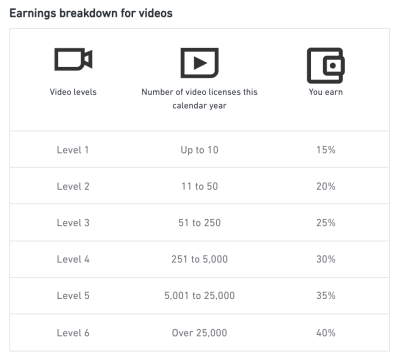If you’ve ever downloaded an image from Shutterstock, you know how fantastic their collection is. But here’s the thing – using these images properly isn’t just about clicking “download.” Properly crediting Shutterstock images is essential, especially if you’re sharing your work publicly or commercially. Not only does it give credit where it’s due, but it also keeps you out of legal trouble. Whether you’re a blogger, designer, or social media manager, understanding how to credit images correctly can save you headaches down the line. Let’s dive into what you need to know about giving proper attribution and respecting
Understanding Shutterstock Licensing and Usage Rights
Before you start using Shutterstock images, it’s crucial to understand the different types of licenses they offer and what rights come with each. Shutterstock primarily provides two types of licenses: Standard and Enhanced. Each has its own rules about how you can use the images, so knowing the differences is key to staying compliant.
Standard License
- Usage: Suitable for online use, social media, blogs, websites, and small print runs (up to 500,000 copies).
- Restrictions: No use in merchandise, large-scale print, or products for resale without an upgrade.
- Attribution: Usually, a credit isn’t required for standard license images, but it’s appreciated if you give credit.
Enhanced License
- Usage: Designed for larger scale uses like merchandise, product packaging, or large print runs.
- Restrictions: Similar to Standard but allows for broader use cases.
- Attribution: Not mandatory, but some clients or platforms may request credit.
Why Proper Licensing Matters
Using an image outside the scope of your license can lead to legal issues, fines, or takedown notices. That’s why understanding what your license permits is so important. Even if attribution isn’t always required, giving credit when possible shows respect for the creator and Shutterstock’s licensing terms. Always review the license agreement attached to your image and keep records of your purchase or license details. This way, if someone ever questions your use, you have proof that you used the image legally and ethically.
How to Properly Credit Shutterstock Images
When attribution is required, it’s best to follow a simple, clear format. Typically, you’d include the photographer’s name, the Shutterstock logo (if specified), and a link back to the image or Shutterstock’s website. Here’s an example:
Photo by John Doe / Shutterstock
If you’re using the image on a website, a small caption or footer credit works well. For social media posts, mentioning the photographer in your caption or tagging their profile (if available) is a good practice. Remember, giving proper credit isn’t just about avoiding legal trouble — it’s also about respecting and supporting the talented creators who contribute to platforms like Shutterstock.
Steps to Properly Credit Shutterstock Images
Using images from Shutterstock can really make your content pop, but it’s super important to give proper credit to respect copyright laws and the creators behind those amazing visuals. Not sure where to start? Don’t worry — here’s a simple step-by-step guide to help you credit Shutterstock images correctly:
Step 1: Know When to Credit
First things first, check the licensing agreement or the image license details. Most Shutterstock images require attribution unless you’ve purchased an extended license that waives this need. When in doubt, it’s safer to give credit. Even if not explicitly required, providing attribution is a good practice that shows respect for the artist and helps your audience find similar content.
Step 2: Gather the Necessary Information
To give proper credit, you’ll need specific details, including:
- The image creator’s name or Shutterstock username
- The image title or description (if available)
- Shutterstock as the image source
- The license type (e.g., Standard or Enhanced)
This info is typically found on the Shutterstock image page or in your download receipt.
Step 3: Craft Your Credit Line
Now that you have all the info, put together a clear and concise credit line. A good rule of thumb is to include the creator’s name, the source, and the license type. For example:
Photo by John Doe / Shutterstock / Licensed under Standard LicenseOr, for a more casual style:
Image by Jane Smith from Shutterstock under Standard LicenseStep 4: Place the Credit Appropriately
Where you put the credit depends on your platform:
- For websites or blogs: Place the credit directly below the image or at the end of the post, preferably close to the image.
- For social media: Include the credit in the caption or in a comment.
- For printed materials: Add the credit in a caption or in the footer of the page.
Consistency is key — always aim for a visible yet unobtrusive placement.
Step 5: Keep Records
Finally, keep a record of your image licenses and credits. This way, if questions arise later, or if you’re audited, you have proof of proper attribution. Save screenshots, license details, and credit lines for your files.
Examples of Correct Shutterstock Image Credits
Seeing some real-world examples can make this whole process clearer. Here are a few sample credits that follow best practices:
Example 1: Blog Post Image
Photo by Alex Johnson / Shutterstock / Licensed under Standard License
Example 2: Social Media Post
Image by Maria Lopez from Shutterstock under Standard License
Example 3: Magazine Footer
| Image Description | Credit Line |
|---|---|
| Sunset over mountains | Photo by Liam Chen / Shutterstock / Standard License |
| Business team collaborating | Image by Sarah Patel from Shutterstock under Standard License |
Remember:
- Always include the creator’s name or Shutterstock username.
- Mention that the image is from Shutterstock.
- Specify the license type if possible.
By properly crediting Shutterstock images, you not only stay on the right side of copyright laws but also show appreciation for the talented artists who make our digital world more beautiful. It’s a small step that makes a big difference!
Common Mistakes to Avoid When Crediting Shutterstock Images
Crediting images properly might seem straightforward at first, but many people stumble into common pitfalls that can lead to legal issues or simply not giving proper recognition. Let’s go over some of the typical mistakes so you can steer clear of them.
1. Forgetting to credit at all
One of the biggest mistakes is not providing any attribution when it’s required. Even if you think an image is free or doesn’t need credit, always double-check Shutterstock’s licensing terms. If attribution is needed, neglecting it can be considered copyright infringement.
2. Using incorrect attribution formats
Shutterstock may have specific requirements for how to credit their images. Common mistakes include misspelling the photographer’s name, omitting the platform’s name, or not including the license type. Always review their recommended attribution format.
3. Mislabeling the image or photographer
Using the wrong photographer’s name or misidentifying the image can cause confusion and potential disputes. Make sure you have the correct details from your download or license confirmation.
4. Ignoring license restrictions
Even with proper credit, some Shutterstock images have restrictions—like not being used for commercial purposes or in sensitive contexts. Always read your license carefully and ensure your usage aligns with the permitted scope.
5. Overlooking updates or changes in licensing terms
Licensing terms can sometimes change or be updated. Keep a record of your licenses and stay informed about any updates from Shutterstock so your credits remain compliant.
6. Failing to include attribution in all formats
If you’re sharing images across multiple platforms—websites, social media, print—make sure your attribution is visible and consistent everywhere it’s needed. Don’t rely on just one location for credit.
Additional Tips for Using Shutterstock Images Legally and Ethically
Using Shutterstock images responsibly isn’t just about avoiding legal trouble—it’s also about respecting the creators who produce the content. Here are some practical tips to help you stay on the right side of the law while being ethical in your usage.
1. Always read the license agreement thoroughly
Before downloading or using any Shutterstock image, take the time to understand the license type you’re purchasing. Whether it’s Standard or Enhanced, each comes with different rights and restrictions. Knowing these details helps prevent accidental misuse.
2. Provide proper attribution when required
If your license or Shutterstock’s guidelines specify attribution, include it clearly wherever the image appears. Use the recommended format, such as:
| Example of Proper Credit |
|---|
| Photo by [Photographer’s Name] on Shutterstock |
Placing the credit close to the image or in a caption ensures viewers see the acknowledgment.
3. Use images within the scope of your license
Stick to the permitted uses—whether for commercial, editorial, or personal projects. Avoid modifications that aren’t allowed or using images in contexts that might be offensive or misleading.
4. Keep records of your licenses and image sources
Having documentation helps prove you have the right to use an image and that you’ve provided proper credit. Save download receipts, license agreements, and any correspondence related to your image usage.
5. Respect the rights of creators
Remember, photographers and artists rely on licensing fees and recognition. Always treat their work with respect—don’t alter images in ways that misrepresent or distort their original intent.
6. Stay updated on Shutterstock policies
Platform rules and licensing options may evolve. Subscribe to Shutterstock updates or check their FAQ regularly to stay informed about best practices and any new requirements.
By following these tips, you’re not only protecting yourself legally but also supporting the creative community that makes sharing high-quality images possible. Responsible image use creates a positive environment for everyone involved!
Conclusion and Summary of Best Practices for Crediting Shutterstock Images
Properly crediting Shutterstock images is essential to respect copyright laws and maintain ethical standards in your content creation. Always ensure you understand the licensing agreement associated with each image, as this determines how you should attribute the work. When giving credit, include the author’s name or Shutterstock, the image title if available, and a link to the original image or Shutterstock’s website. This not only fulfills legal requirements but also supports the creators behind the images.
Here are some best practices to follow:
- Check licensing terms: Different licenses may have varying attribution requirements.
- Use clear attribution: Place credits in a visible location near the image or in a dedicated credits section.
- Include necessary details: Author’s name, image title, and Shutterstock URL or attribution text.
- Maintain consistency: Use a standard format for all image credits across your content.
- Keep records: Save proof of licensing and attribution for future reference or legal compliance.
By adhering to these best practices, you ensure your use of Shutterstock images is both legally compliant and respectful to the creators. Proper crediting enhances your credibility and demonstrates your commitment to ethical content sharing. Remember, when in doubt, consult Shutterstock’s licensing guidelines or seek legal advice to avoid potential copyright issues.



